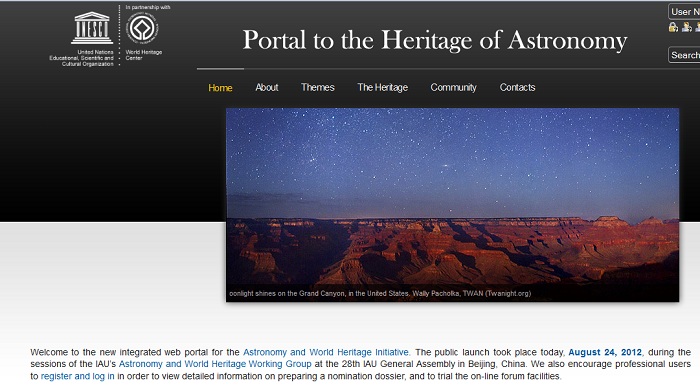-

What is astronomical heritage?
Astronomical heritage is evidence relating to the practice of astronomy and to social uses and representations of astronomy. It exists in the form of the tangible remains of monuments, sites and landscapes with a link to the skies that constitute a well-defined physical property. It can also involve movable objects such as instruments and archives, intangible knowledge—including indigenous knowledge still preserved in the world today—and natural environments that support human interest in astronomy, for example through the cultural use of their horizons or dark night skies.
Astronomy in context
Practices related to astronomy are inextricably linked to broader assemblages of cultural activities. As a result, the material heritage of astronomy in the form of artefacts and constructions is often deeply integrated within material heritage of a broader nature and significance. This is equally true whether or not the astronomy in question constitutes modern ‘rational’ science. The pre-Columbian metallurgical centre at Viña del Cerro in Chile, for instance, provides an excellent example of astronomy in a broader, integrated context of resource exploitation, sacred places, calendar and landscape.
This implies that we should not focus exclusively upon ‘astronomical heritage sites’ per se but pay due attention to sites exhibiting an important set of valuable attributes, astronomy being just one component among others. An excellent example in this regard is the Einstein Tower in Potsdam, Germany, built in the 1920s, which combines outstanding scientific and architectural qualities.
Ulugh Beg’s observatory in Samarkand, Uzbekistan, is an example of the mutual reinforcement of value coming from different cultural fields—urban, social and political history, history of architecture and decoration, cultural practices in the arts, etc.—in Central Asia during the 15th century. The immediate urban surroundings of the 18th-century Jantar Mantar observatory in Jaipur, India, inscribed onto the World Heritage List in 2010, provide another example where overlapping aspects of value are gathered together in one property; similarly, Dengfeng Observatory in China, also inscribed in 2010, forms part of a large site including a range of 13 temples, towers, a monastery, and gardens.
Astronomy can take many forms but it is never alone: it is always a part of a larger ensemble of attributes that characterise a human society in its particular geographical and historical context.
The heritage of astronomy is often linked to complex systems of representation. For example, astronomical observations are frequently motivated by a need to predict the future (for various reasons including prognostication, predicting recurrent phenomena, or ‘testing’ hypotheses in modern ‘rational’ context), and this leads to the development and use of a variety of forms of symbolic notation. As a result, attempting to interpret the heritage involves examining the diverse relationships that exist between human beings and the sky as manifested through the use of artefacts and representations. These not only include notations and drawings but also architectural constructions and urban planning that ‘symbolise’ the skies in various ways: terrestrial material manifestations of the human cognisance of the universe that can be seen as a concretisation of the human relationship with the heavens. We must also be concerned with protocols and methods of observation, together with a full range of beliefs and modes of behaviour (i.e. magic as well as science, astrology as well as astronomy in the modern rational sense, and religious faiths as well as beliefs in physical laws).
This raises the issue of the meaning of the term ‘science’, both as simple terminology and as a more complex epistemological question. One can envisage, effectively, a straightforward dichotomy between modern ‘rational’ methods of enquiry (narrow definition of science) and any attempt to comprehend the nature of the perceived life-world by imposing some sort of cognitive structure upon it (wide definition). However, at a more subtle level the question of what constitutes ‘pure science’ in astronomy remains extremely open and dependent upon context. It is certainly allied to the question of predicting the future and it is also linked with cosmology (in the anthropological sense) and with religion and ideology. The general question of what constitutes ‘pure’ science or ‘pure’ astronomy is relevant in so far as it helps to define modes of connection between astronomical beliefs and practice and their social and cultural context and hence leads to more efficient ways of understanding the value of heritage sites with a relationship to astronomy.
An important category of astronomical heritage relates to the application of astronomical techniques and technology to other sciences. Thus the Struve geodetic arc represents astronomy as technology applied to earth science. Space science, in the sense of science carried out in space, may include astronomy but the fixed heritage associated with space science is purely technological.
Mehr darüber zu erfahren und eine Menge von Informationen gibt es hier: http://www2.astronomicalheritage.net/index.php/
